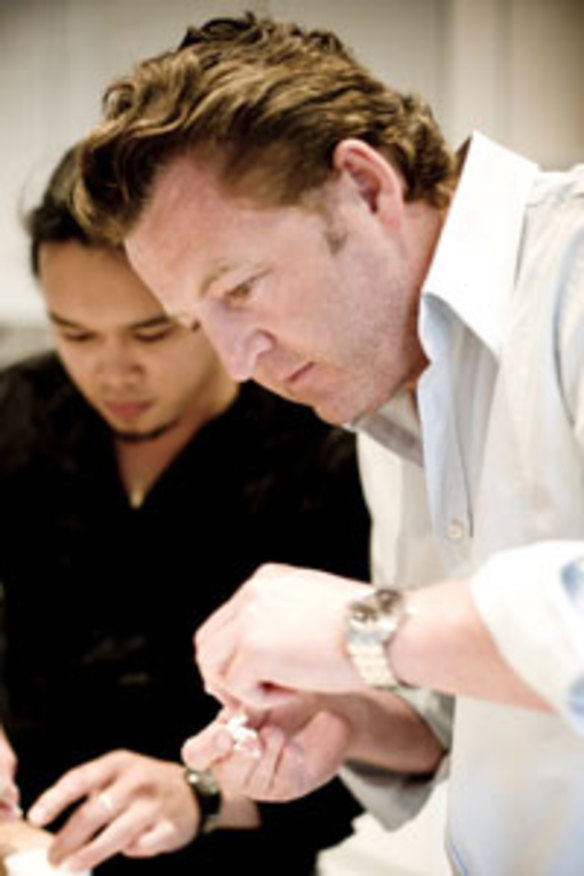The Palace by Luke Mangan

Contemporary$$
Score: 14/20
I’M SITTING on a banquette at The Palace by Luke Mangan, sipping my Luke Mangan pinot noir, eating bread dipped in Luke Mangan olive oil, reading a menu that finishes with a list of Luke Mangan homewares.
Welcome to Mangan World, an unabashed celebration of a celebrity chef making his long-overdue hometown debut. There will be no hiding of one’s cheffy light under a bushel at this resurrected old boozer — quite the opposite, in fact.
Like God, Mangan is unseen yet everywhere, from the monogrammed shirts on the staff to his prominently placed cookbook, to the multiple product lines bearing his name.
Do we deduct points for the fact the titular chef won’t be part of the day-to-day operations of his South Melbourne gastropub — aside from the odd visit, during which it is undeniably thrilling to have the man himself dish up your steak tartare while cracking jokes (on second thoughts, perhaps he wasn’t joking) about putting his name to a line of mustards? I think not.
The same dilemma was presented by a recent opening at Crown and while I can understand cynicism towards ‘‘name’’ chefs leveraging their brand beyond all recognition, the restaurant business increasingly requires a chef to be more than a person who’s simply a creative cook.
The success of The Palace rests on the crew he’s put in place, including the chef — a long-standing Mangan lieutenant known as MJ — an efficient crew of waiters and an accessible wine list with plenty of familiar names that won’t scare the bank manager.
There have been so many self-proclaimed, yet loosely defined, gastropubs popping up, the term has been stripped of meaning. But I reckon The Palace embodies the central conceit well — accomplished bistro food augmented by a sturdy wine list in an unpretentious setting.
Yet it certainly isn’t the most glamorous of the new breed. The room is functional rather than lovely. The cruelly utilitarian floor covering is of the sort normally found in government buildings. Gold-framed prints from Charles Blackman’s Alice series hang on the walls but the best entertainment is provided via a glass wall that separates the kitchen from the dining area, displaying its hum minus the sound of crashing pans.
The Palace appears to have become the adopted home of ladies who lunch, which tells you something about the state of dining in Melbourne. Lynch’s has closed; the Bot has also closed for renovations. The Palace has taken the mantle because not only is it bayside, it isn’t too threatening or fancy, the portions are good and menfolk are made to feel comfortable with a solid and masculine selection of steaks.
The menu is unusually broad — 12 entrees plus a selection of charcuterie, five steaks, six mains proper and three larger dishes (including roast chicken with all the bits and pieces) for two to share. Knowingly populist, it weaves old-school items such as chicken liver parfait ($14) and caesar salad ($16) with modern classics. The ubiquitous salt and pepper squid, for instance, has a rare advantage over its competitors, being both very salty and very (Szechuan) peppery, but it exhibits a strange dual personality in saddling up with a parsnip puree and a pickled cucumber and green papaya salad, with a dish of Thai-style sauce.
Almost mayo-like in its creaminess, the puree works just fine with the calamari on its own, although I’d advise against going the trifecta.
There’s more Asian bias, minus any confusion, with an omelet folded over generous pieces of sweet blue swimmer crab ($21), the richness offset by a soulful miso-mustard broth; texture and subtle flavour provided by crisp circles of fried onion, enoki mushrooms, finely shredded red chilli and torn mint. Faultlessly lovely.
If The Palace still has any proving to do, it arrives in a main of confit duck leg ($34) with a caramelised half pear and creamy mash in a moat of lightly cinnamon-spiked cooking juices. It’s one of those bistro classics that so often fails in the execution. This one is the exemplar of the species: perfect presentation, great flavour.
There’s more simple enjoyment with baby snapper. Whole but filleted, it arrives with its head and tail — a good idea and certainly something I haven’t seen before, although there are still a number of bones for the unwary. Pan-fried then finished in the oven, it arrives in a buttery sauce with capers and cherry tomatoes, whole prawns and mussels.
And the negatives? The fries ($9). Their colour should have given it away; they needed a bit more time in the cooker. But moving on from the disappointment of flaccid chips, there’s dessert: a classic Eton mess, ($15) with whole strawberries and their sweet liquid essence, meringue and vanilla cream. There’s really not much to say about it except that it’s gloopily, dopily, easy to like.
More challenging is a liquorice parfait with lime ($16), a new benchmark for the marriage of ingredients with clashing personalities. The dense cylinder of aggressively liquorice-flavoured parfait with wedges of fresh lime and a liberal splash of lime syrup is an eye-popping assault on the senses, a knife-edge balance between great and awful that somehow snatches victory.
It’s one of those times as a food writer that you get all excited at the prospect of telling the readers about a discovery, until the waitress mentions that it was featured on a little show called MasterChef a couple of days earlier. So you probably know all about it already. Just as you probably already know that Luke Mangan runs a good gastropub in South Melbourne. Even if he isn’t actually there.
SOURCE: Epicure
Restaurant reviews, news and the hottest openings served to your inbox.
Sign up